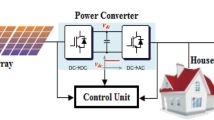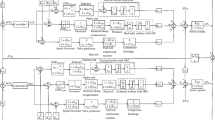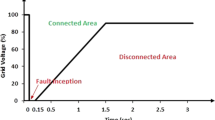Abstract
Power system often suffers from low frequency oscillations (LFOs) which might result in instability in the long run, if allowed to sustain in the system for a long time. In order to mitigate these oscillations, power system stabilizers (PSS) are used through excitation control. Three recently developed meta-heuristic algorithms namely: Collective Decision Optimization (CDO), Grasshopper Optimization Algorithm (GOA) and Salp Swarm Algorithm (SSA) have been applied for the optimal tuning of PSS parameters for small signal stability analysis of a renewable integrated power network. This was done by designing a conventional speed-based lead-lag PSS in a multi-machine interconnected power system, whose parameters have been tuned using CDO, GOA and SSA in a way to shift all the eigenvalues associated to electromechanical modes to the left half of S plane. Comparison of the results obtained by the algorithms demonstrates the superiority of SSA over GOA and CDO to boost the overall system stability over a wide range of operating conditions. The PSS controller designed using SSA is observed to be more robust and efficient in damping out oscillations under different operating conditions.














Similar content being viewed by others
Abbreviations
- PSSs:
-
Power system stabilizers
- CDO:
-
Collective Decision Optimization
- GOA:
-
Grasshopper Optimization Algorithm
- SSA:
-
Salp Swarm Algorithm
- PLL:
-
Phase Locked Loop
- MPPT:
-
Maximum Power Point Tracking
- LFOs:
-
Low frequency oscillations
- LTI:
-
Linear time-invariant
- RS and RP :
-
Parasitic resistance
- D:
-
Duty ratio
- \(\Delta \omega\) :
-
Angular Frequency Deviation
- \(\delta\) :
-
Rotor Electrical Angular Position
- \(P_{e}\) :
-
Output electrical power
- \(i_{fd}\) :
-
Field current
- \(V_{t}\) :
-
Generator terminal voltage
- \(X^{\prime}_{d}\) :
-
Direct axis transient reactance
- \(R_{f}\) :
-
Rate feedback
- \(E^{\prime}_{d}\) :
-
Direct axis component of voltage behind \(X^{\prime}_{q}\)
- \(T_{A}\) :
-
Voltage regulator time constant
- \(T_{2}\) and \(T_{4}\) :
-
Phase-lag time constants
- GH :
-
Grasshopper
- LD :
-
Leaders
- FL :
-
Followers
- ub :
-
Upper bound
- lb :
-
Lower bound
- DAE:
-
Differential algebraic equations
- SSSA:
-
Small signal stability analysis
- PV:
-
Photovoltaic
- G:
-
Solar irradiation
- \({\Delta I}_{L}\) :
-
Ripple current
- \(T_{w}\) :
-
Time constant of washout filter
- \(E_{fd}\) :
-
Field voltage
- H :
-
Inertia constant of the generator
- \(T^{\prime}_{d0}\) :
-
Short circuit direct axis transient time constant
- \(X_{d}\) :
-
Direct axis synchronous reactance
- \(X^{\prime}_{q}\) :
-
Quadrature axis transient reactance
- \(T_{M}\) :
-
Mechanical torque to the shaft
- \(S_{E} (E_{fd} )\) :
-
Saturation function
- \(K_{PSS}\) :
-
Power system stabilizer gain
- \(J\) :
-
Objective function
- WSCC:
-
Western system coordinating council
- maxFE:
-
Maximum fitness evaluation
- FE:
-
Fitness evaluation
- SW:
-
Swarm
- EMs:
-
Electromechanical modes
- VSI:
-
Voltage source inverter
- STC:
-
Standard temperature condition
- SOFs:
-
Sub-objective functions
- L:
-
Inductor
- C:
-
DC link capacitor
- \(\omega\) :
-
Rotor electrical angular velocity
- \(P_{m}\) :
-
Input mechanical power
- \(\xi\) :
-
Damping ratio
- \(T^{\prime}_{q0}\) :
-
Short circuit quadrature axis transient time constant
- \(X_{q}\) :
-
Quadrature axis synchronous reactance
- \(V_{R}\) :
-
Output of Aaplifier
- \(E^{\prime}_{q}\) :
-
Quadrature axis component of voltage behind \(X^{\prime}_{d}\)
- \(K_{A}\) :
-
Voltage regulator gain
- \(\sigma\) :
-
Real part of eigenvalues
- \(T_{1}\) and \(T_{3}\) :
-
Phase-lead time constants
References
Sauer PW, Pai MA (1998) Power system dynamics and stability, vol 101. Prentice hall, Upper Saddle River
Kundur P, Balu NJ, Lauby MG (1994) Power system stability and control, vol 7. McGraw-hill, New York
Padiyar KR (2008) Power system dynamics. BS publications, Hyderabad
Anderson PM, Fouad AA (2008) Power system control and stability. Wiley, Hoboken
Werner H, Korba P, Yang TC (2003) Robust tuning of power system stabilizers using LMI-techniques. IEEE Trans Control Syst Technol 11(1):147–152
Taranto GN, Chow JH (1995) A robust frequency domain optimization technique for tuning series compensation damping controllers. IEEE Trans Power Syst 10(3):1219–1225
Abido MA (2000) Pole placement technique for PSS and TCSC-based stabilizer design using simulated annealing. Int J Electr Power Energy Syst 22(8):543–554
Mondal D, Chakrabarti A, Sengupta A (2011) PSO based location and parameter setting of advance SVC controller with comparison to GA in mitigating small signal oscillations. In: 2011 International Conference on Energy, Automation and Signal, pp. 1–6, IEEE
Panda S, Padhy NP (2007) Regular paper robust coordinated design of PSS and TCSC using PSO technique for power system stability enhancement. J Electr Syst 3(2):109–123
Dong ZY, Makarov YV, Hill DJ (1997) Genetic algorithms in power system small signal stability analysis, pp 1–6
Zhang P, Coonick AH (2000) Coordinated synthesis of PSS parameters in multi-machine power systems using the method of inequalities applied to genetic algorithms. IEEE Trans Power Syst 15(2):811–816
Stativă A, Gavrilaş M, Stahie V (2012) Optimal tuning and placement of power system stabilizer using particle swarm optimization algorithm. In: 2012 International Conference and Exposition on Electrical and Power Engineering, pp 242–247. IEEE.
Safari A (2013) A PSO procedure for a coordinated tuning of power system stabilizers for multiple operating conditions. J Appl Res Technol 11(5):665–673
Mostafa HE, El-Sharkawy MA, Emary AA, Yassin K (2012) Design and allocation of power system stabilizers using the particle swarm optimization technique for an interconnected power system. Int J Electr Power Energy Syst 34(1):57–65
Panda S (2011) Robust coordinated design of multiple and multi-type damping controller using differential evolution algorithm. Int J Electr Power Energy Syst 33(4):1018–1030
Panda S (2009) Differential evolutionary algorithm for TCSC-based controller design. Simul Model Pract Theory 17(10):1618–1634
Ameli A, Farrokhifard M, Ahmadifar A, Safari A, Shayanfar HA (2013) Optimal tuning of Power System Stabilizers in a multi-machine system using firefly algorithm. In: 2013 12th International Conference on Environment and Electrical Engineering, pp 461–466, IEEE.
Elazim SA, Ali ES (2016) Optimal power system stabilizers design via cuckoo search algorithm. Int J Electr Power Energy Syst 75:99–107
Abido MA, Abdel-Magid YL (2002) Optimal design of power system stabilizers using evolutionary programming. IEEE Trans Energy Convers 17(4):429–436
Abido MA (1999) A novel approach to conventional power system stabilizer design using tabu search. Int J Electr Power Energy Syst 21(6):443–454
Abido MA (2000) Robust design of multimachine power system stabilizers using simulated annealing. IEEE Trans Energy Convers 15(3):297–304
Sambariya DK, Prasad R (2014) Robust tuning of power system stabilizer for small signal stability enhancement using metaheuristic bat algorithm. Int J Electr Power Energy Syst 61:229–238
Mishra S, Tripathy M, Nanda J (2007) Multi-machine power system stabilizer design by rule based bacteria foraging. Electr Power Syst Res 77(12):1595–1607
Dong ZY, Makarov YV, Hill DJ (1997) Genetic algorithms in power system small signal stability analysis.
Ameli A, Farrokhifard M, Ahmadifar A, Safari A, Shayanfar HA (2013) Optimal tuning of power system stabilizers in a multi-machine system using firefly algorithm. In: Environment and Electrical Engineering (EEEIC), 2013 12th International Conference on, pp 461–466, IEEE.
Saidur R, Rahim NA, Islam MR, Solangi KH (2011) Environmental impact of wind energy. Renew Sustain Energy Rev 15(5):2423–2430
Shahsavari A, Akbari M (2018) Potential of solar energy in developing countries for reducing energy-related emissions. Renew Sustain Energy Rev 90:275–291
Bambace LAW, Ramos FM, Lima IBT, Rosa RR (2007) Mitigation and recovery of methane emissions from tropical hydroelectric dams. Energy 32(6):1038–1046
Liu S, Liu PX, Wang X (2015) Stochastic small-signal stability analysis of grid-connected photovoltaic systems. IEEE Trans Industr Electron 63(2):1027–1038
Dahal S, Mithulananthan N, Saha T (2010) Investigation of small signal stability of a renewable energy based electricity distribution system. In: IEEE PES General Meeting, pp 1–8, IEEE
Ogata K (1995) Discrete-time control systems, vol. 2. Prentice Hall, Englewood Cliffs, pp 446–480
Rogers G (2012) Power system oscillations. Springer Science & Business Media, Berlin
Martins N (1986) Efficient eigenvalue and frequency response methods applied to power system small-signal stability studies. IEEE Trans Power Syst 1(1):217–224
Klein M, Rogers GJ, Moorty S, Kundur P (1992) Analytical investigation of factors influencing power system stabilizers performance. IEEE Trans Energy Convers 7(3):382–390
Martins N, Lima LT (1990) Determination of suitable locations for power system stabilizers and static VAR compensators for damping electromechanical oscillations in large scale power systems. IEEE Trans Power Syst 5(4):1455–1469
Shubhanga KN, Anantholla Y (2006) Manual for a multi-machine small-signal stability programme. Dept. of Electrical Eng. NITK, Surathkal
Machowski J, Lubosny Z, Bialek JW, Bumby JR (2020) Power system dynamics: stability and control. Wiley, Hoboken
Pavella M, Murthy PG (1994) Transient stability of power systems: theory and practice.
Dey P, Mitra S, Bhattacharya A, Das P (2019) Comparative study of the effects of SVC and TCSC on the small signal stability of a power system with renewables. J Renew Sustain Energy 11(3):033305 (pp 1–14)
Mitra S, Bhattacharya A, Dey P (2018) Small signal stability analysis in co-ordination with PSS, TCSC, and SVC. In: 2018 International Conference on Computation of Power, Energy, Information and Communication (ICCPEIC) (pp 434–441). IEEE.
Dey P, Bhattacharya A, Datta J, Das P (2017) Small signal stability improvement of large interconnected power systems using power system stabilizer. In: 2017 2nd International Conference for Convergence in Technology (I2CT) (pp 753–760). IEEE.
Kashyap A (2015) Small-signal stability analysis and power system stabilizer design for grid-connected photovoltaic generation system (Doctoral dissertation, Carleton University).
Dey P, Bhattacharya A, Das P (2017) Tuning of power system stabilizer for small signal stability improvement of interconnected power system. Appl Comput Inf 1–14
Dey P, Bhattacharya A, Das P (2019) Tuned power system stabilizer for enhancing small signal stability of large interconnected power system. Caribbean J Sci 53(1):15 (pp 843–857)
Hauke B (2009) Basic calculation of a boost converter's power stage. Texas Instrum Appl Rep 1–9
Villalva MG, Gazoli JR, Ruppert Filho E (2009) Comprehensive approach to modeling and simulation of photovoltaic arrays. IEEE Trans Power Electron 24(5):1198–1208
Zhang Q, Wang R, Yang J, Ding K, Li Y, Hu J (2017) Collective decision optimization algorithm: a new heuristic optimization method. Neurocomputing 221:123–137
Saremi S, Mirjalili S, Lewis A (2017) Grasshopper optimisation algorithm: theory and application. Adv Eng Softw 105:30–47
Mirjalili S, Gandomi AH, Mirjalili SZ, Saremi S, Faris H, Mirjalili SM (2017) Salp Swarm Algorithm: a bio-inspired optimizer for engineering design problems. Adv Eng Softw 114:163–191
Author information
Authors and Affiliations
Corresponding author
Additional information
Publisher's Note
Springer Nature remains neutral with regard to jurisdictional claims in published maps and institutional affiliations.
Rights and permissions
About this article
Cite this article
Dey, P., Saha, A., Bhattacharya, A. et al. Analysis of the Effects of PSS and Renewable Integration to an Inter-Area Power Network to Improve Small Signal Stability. J. Electr. Eng. Technol. 15, 2057–2077 (2020). https://doi.org/10.1007/s42835-020-00499-2
Received:
Revised:
Accepted:
Published:
Issue Date:
DOI: https://doi.org/10.1007/s42835-020-00499-2




